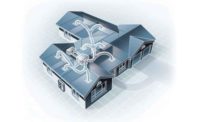Per an article, titled, “Guidance for Building Operations During the COVID-19 Pandemic” published this spring, “The HVAC systems in most nonmedical buildings play only a small role in infectious disease transmission, including COVID-19. Preliminary research has been recently released, due to the urgent need for information, but it’s likely to take years to reach scientific consensus.
While I agree with the above, American workers’ urgency to get back to work is causing the HVAC industry to respond as quickly as possible to provide safe building HVAC systems before the industry settles upon a “scientific consensus.” In today’s coronavirus pandemic, even a “small role” is critical than ever, as people won’t be safe as long as there is some potential risk in the HVAC system, no matter how small or large.
The increased spread of severe acute respiratory syndrome coronavirus 2 (SARS-CoV-2), the cause behind COVID-19 infections worldwide, has brought increased attention on the prevention and control of SAR-CoV-2 by HVAC systems in buildings, as Americans spend 90% of their time inside. We are facing the challenges to deal with the potential virus spread through the existing building HVAC system in all types of buildings using central HVAC systems, including hospitals, health care facilities, senior houses, prisons, public transportation, colleges and schools, commercial offices, movie theaters, hotels, restaurants, malls, etc.
Limitations of Standard Air-Handling Units
Since the COVID-19 virus is spread from person to person through coughing or sneezing, virus-carrying airborne droplets can remain in the air or on surfaces for hours even after the ill person is no longer near. Current standard air-handling units (AHUs) in HVAC systems circulate up to 80%-90% of the air in regular systems during peak-load conditions, such as winter and summer, when outdoor ventilation airflow is set at the minimum percentage to save energy. Standard filtration units in HVAC systems cannot remove the virus within an airstream effectively; the HVAC system has become the “hub” to spread the virus by recirculating contaminated air into space.
With limited outdoor fresh air to mix with the re-circulated room air, most of the contaminates are not removed or well diluted, which means it could travel inside the building areas and spread from one room to another room(s) all the time as long as the HVAC system is running.
Part 1: The All Fresh Air Super-Clean Building (AFSCB) Approach
As everyone in the industry is looking for solutions to control the COVID-19 infection, the best practice for health care facility HVAC systems can be adopted with modifications. [2]
COVID-19 is mainly transmitted through two primary means: direct contact and airborne.
Direct contact includes hand contact or contact with infected liquid droplets produced by a sneeze, cough, or talking with an infected person. The best solution is to prevent direct contact by keeping social distance, wearing a face mask, and washing hands often.
Airborne transmissions originate from the respiration of particles or aerosols of low mass and size (1.0-5.0 micros) that can remain indefinitely suspended in air. Solutions include implementing 100% outdoor fresh air and eliminating recirculated air. As occupants may carry the virus, the safest way to eliminate infection is to exhaust the air 100%, and intake 100% outdoor fresh air through ultra-low particulate air (ULPA) filters. The 100% outdoor air AHU will require a large amount of cooling, heating, and humidification capacity, so the equipment and operation costs will be higher than current recirculating AHU.
AFSCB Design Concept
1. Air Contamination — As there is no recirculated air from the occupied spaces within a building, 100% outside AHUs with ULPA filtration and integrated disinfection devices, such as UV light, will achieve the ultimate goal of no occupant contamination through the HVAC system. (Social distancing, handwashing, and all other guidelines by the Centers for Disease Control and Prevention [CDC] must still be followed by all occupants.)
2. ULPA Filter — The estimated size of SARS-CoV-2 virus is 0.12 microns. The higher the efficiency of the filter, the better chance that the virus-containing particles and droplets can be removed. Before we have further understanding of the virus by research, the first step in redesigning the AHU in an HVAC system is to apply the best filter, like wearing the qualified face mask. A ULPA filter can remove at least 99.999% of dust, pollen, mold, bacteria, and any airborne particles from the air with a minimum particle penetration size of 100 nanometers (0.1 µm). The highly efficient filter has high pressure drop of the airstream, so it will require properly sized fans in an AHU as well as more frequent maintenance to replace the filter as it catches more particles and gets loaded quicker than low-efficient filters.
Replacing existing AHUs with highly efficient filters is not recommended, as the existing fan cannot handle the high-pressure loss, which could force the air to bypass the filter bank without filtration.
3. Ultraviolet (UV) Lamps — Per the National Air Filtration Association (NAFA), a properly designed and maintained UV system, often in concert with filtration, humidity control, and airflow management, has been shown to reduce infections from other viruses. The details of the system are very important (e.g., design of fixtures, lamp type, lamp placement airflow amount and mixing, etc.). Simply adding UV to an existing system without consideration of these factors has not been demonstrated to have a benefit. [1]
4. Airflow Rate and Pattern — With a combination of appropriate design of higher air-change rates and uniform direction, similar to the cleanroom design, airflow can “wash” away particles from occupants. This will need further study, including computational fluid dynamics (CFD) modeling. A cleanroom is defined by ISO14644-1 as a room in which the concentration of airborne particles is controlled. Such a room is constructed and used in a manner to minimize the introduction, generation, and retention of particles inside the room, controlling other relevant parameters, e.g., temperature, humidity, and pressure, as necessary.
Cleanrooms are typically used in pharmaceutical and semi-conductor manufacturing or scientific research labs. They are controlled environments that have a low level of pollutants, such as dust, airborne microbes, aerosol particles, and chemical vapors.
Cleanrooms are specially constructed, environmentally controlled enclosed spaces where the concentration of airborne particles (contaminants) is kept within specified limits.
The HVAC systems supply high amounts of airflow (defined by air change per hour) and maintain vertical flow (top supply, low wall return/exhaust) to achieve the clean room classification or grade by regulatory, such as federal industry standard 209 and ISO 14644-1).
5. Energy Conservation — An energy recovery device, such as a heat pipe, run-around loop, shall be considered in an AHU to reduce energy cost. Energy-efficient devices and systems shall be applied with this 100% outside system, such as a chilled beam system, which can cover most of the building sensible cooling load and heating load. The 100% outside air AHU will only need to prevent sufficient ventilation air for occupants and keep proper air velocity to direct the airflow from the supply terminals to the exhaust terminals.
6. Temperature, Humidity, UV Lights, and More — Depending on the research developed around the world, the relation between the virus and temperature and relative humidity will be identified. An HVAC system can play a big role in controlling a room’s conditions to eliminate the virus or at least prevent it from growing.In summer, with a cooling coil, the temperature and humidity can be controlled. In winter, a humidifier must be used with a heating coil to achieve 40%-60% relative humidity, which is found to be the right range to reduce the half-life of the coronavirus by researchers. Numerous technologies are available to reduce the presence of contaminants. Ultraviolet lights, ultraviolet photocatalytic oxidation, ionization, plasma, electrostatic active, active carbon, and other components can be installed to specifically target volatile organic compounds (VOC), bacteria, and viruses. Some of these options can be available as integral parts of the HVAC system.
7. Electrical System Upgrade ---Rather than just provide comfort before, now the HAVC system need to operate continuously to ensure the safety of the occupants, consider emergency power supply to support the HAVC system during power outage.
Part 2: AFSCB: Safety and Attractiveness
Indoor air safety will certainly be a building’s most important attribute during and after the COVID-19 pandemic. Building occupants would rather spend more on utility costs to achieve the safest daily environment than place their health at risk. The industry has to rewrite the rules.
Utilizing today’s HVAC technology, a 100% outside air system can be affordable.
The 100% outdoor air system with reduced airflow (a chilled beam system), combined with an energy recovery system, may offset part of the extra cost from conditioning outside air all year-round. Other control methods, such as on-demand ventilation, can also be applied to further reduce the cost.
More research (such as CFD modeling) needs to be done to find the best air distribution, which will determine the minimal flowrate and pattern to maintain the best way to prevent virus spread.
Part 3: Retrofit of Existing Buildings
For existing buildings, it will be challenging to upgrade them to a 100% outdoor air system due to the restraints of space and power supply. It has to be analyzed case by case.
Here are some preliminary design concepts for difference building types.
1. Hospital and Health Care Facility — Most of the HVAC systems in hospitals and health care facilities have the capability to be upgraded to 100% outdoor air systems, as the existing systems operate with large capacities to condition larger amounts of outside air and sufficient electrical power supplies. Utility plants (boilers and chillers) can be expanded relatively easy. Replacing the AHU may be the quickest and easiest way, along with adding associated exhaust fans at the roof level. Air ductwork can stay the same, while an energy recovery system shall be considered.
2. Nursing Homes — It depends on the existing HVAC system. if individual a/c units are used in each residence, each unit can be replaced with 100% outdoor units. (Currently, such commercial a/c units will need to be custom-ordered). If the existing HVAC system is a central air system, refer to No. 1 above.
3. School — Similar to No. 2, some schools may have a combination of a central air system for ventilation and local fan coil units for cooling and heating. A study shall be conducted to find the minimal airflow to maintain a safe air pattern to flush away the virus.
4. Offices — Usually equipped with a central air system with VAV boxes, a designer should consider replacing the AHU and add an exhaust fan.
5.Stores — Depending on the number of occupants, these facilities are usually equipped with a central air system with VAV boxes. A designer should consider replacing the AHU and adding an exhaust fan.
6. Public Transportation — Depending on the number of occupants, these facilities are usually equipped with central air system with VAV boxes. A designer should consider replacing the AHU and adding an exhaust fan.










